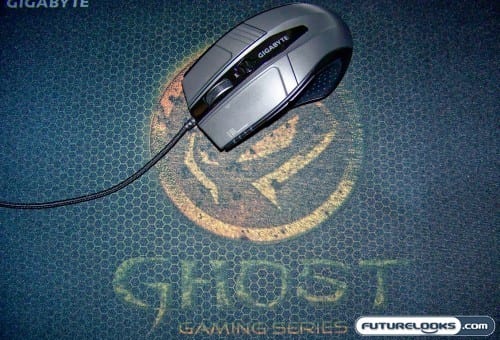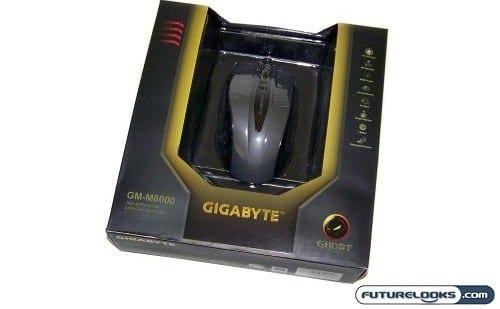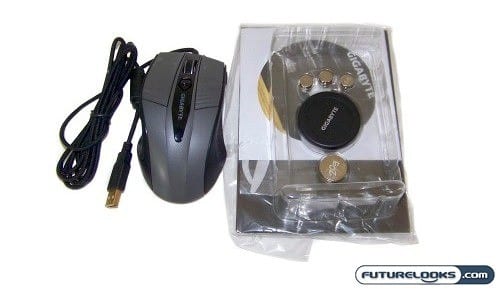
GIGABYTE does a lot more than just sweet motherboards and graphic cards. Since they provide the basics needed to build an elite gaming system, it’s no surprise to see them investing their resources to develop peripherals that can be used to support their main components. Some of those peripherals include hard disk enclosures, storage, monitors, speakers, keyboards, and of course, gaming mice.
Today we get a chance to check out one of their latest products. The GIGABYTE GM-M8000 High Performance Gaming Mouse combines frickin’ lasers (or laser) with style and a host of buttons. Is this just a hopped up office mouse or is it a true gaming rodent? Let’s find out!
Features and Specifications

There are a few features that the GM-M8000 offers that you’re not going to find in every gaming mouse. In fact, what separates this mouse from your average gaming mice are the extra button functions as well as some of the built-in features like the gold-plated USB connector, configurable weights and the five programmable buttons.
As it would seem, the GM-M8000 also has a few other tricks under the hood. A quick look at the spec sheet reveals some more impressive looking data which includes:
- High-Performance (AVAGO 6090) Sensor
- Four button controlled adjustable sensitivity settings
- 4000 dpi maximum sensitivity
- 16-bit Data path
- 15 customizable macro settings
- 8KB onboard memory (for GHOST Software)
- 24 point position scroll wheel
- Ergonomic shape for improved experience
Besides the typical main buttons, there are two left side buttons as well. However, the wheel function offers two more left and right buttons when pushed to side. The small button on the right side changes the color of the GIGABYTE name from red to green to blue.
Dumping the Box Contents Out

Inside the box wyou’ll find a securely packaged GM-M8000 mouse, mouse weights, extra mouse feet, a CD with drivers, and the GIGABYTE GHOST software utility that configures the mouse to your needs. This utility is used to customize “on the fly” DPI settings among other things. We’ll look at this in depth shortly.
Another unique piece of the package are the mouse weights. Naturally, the weights are used to make the mouse a little heavier if needed. Everyone has a different preference for how their mouse feels so GIGABYTE panders to this demographic. Too light? Too heavy? Just customize it to your whim for that extra edge.
The GM-8000 Mouse Up Close
It’s interesting that the first thing we all do when we see a new mouse is handle it. But, that’s what our instincts tell us to do. It’s then and there that we decide whether we like or dislike a mouse. The same can be said about keyboards and joysticks.
I handled the mouse a bit, simulating gaming movement, button pressing, hand, and finger positioning. For my particular hand size and finger length, the mouse is about as perfect as can be. The curvature of the mouse cups nicely which works well in respect to the top and side buttons. The left side buttons are particularly well placed and easy press. Even the 4-function wheel works well with the elongated shape of the mouse.
One thing I find to be a gaming mouse requirement these days is the use of stickier materials around the sides where the fingers grip the mouse. The more controllable the mouse, the better the gaming experience. The M8000 actually has rubber grips covering at least two-thirds of the mouse’s sides for optimal grip.
Just in front of the mouse wheel, you’ll find the the DPI button. Pushing the button forward increases the DPI response which is displayed by four red LEDs built in to the front left of the mouse. As you push the button forward, one LED lights up till it reaches the fourth at which point you’ll be using the mouse’s full 4000-DPI function.
Flipping the mouse over, you can see the Teflon mouse feet, 16-bit laser sensor, and weight chamber. The Teflon feet should last quite a bit longer than typical materials found on non-gaming mice. As for the chamber, a simple twist will remove the cap. Inside is a thin foam insert designed to hold the weights in place so they don’t rattle around. You can insert a maximum three smaller 6 gram weights and up to one more large 20 gram weight.
Installation and Software
Since most mice work via plug and play, the GHOST software is only necessary if you want to activate the GM-M8000s’s hidden capabilities. You can program a Macro for any button on the mouse with any keyboard key. My only warning is to carefully choose a standard macro for the Re-Pressing to Stop and Release to Stop buttons lest you find 75+ browswer windows open all of a sudden.
GHOST allows you to also set the mouse Sensitivity to 1000, 1600, 3200, and 4000 DPI. The higher the DPI, the more accurate your pointer or in-game crosshair. Unfortunatley, I found myself having to set the DPI value to 4000 every time after closing the program. It doesn’t save my last settings. It would be nice if it did.
There is also an option to operate the mouse in Microsoft Intelli-Mouse mode or Advanced Mouse Mode which directly tie in to the drivers. It’s not uncommon for there to be conflicts between Windows and gaming peripheral software. Having this Intellimouse option will come in handy if you notice any issue.
The nice thing about the software is that it’s fully compatible with 32-bit and 64-bit Windows as tested. Also, the GHOST software doesn’t have to be running if you want to use the mouse’s DPI function.
Measuring the M8000’s Head Shot Accuracy
How does one rate a gaming mouse’s performance? Well, there’s really no set standard so a method to my madness had to be devised. GIGABYTE’s new GP-MP8000 Gaming-grade Mouse Pad and Razer Destructor Pro Gaming Mouse Pad were utilized as the test surfaces of choice. Both have proven to be a very good gaming surfaces for 1600 or higher DPI high-performance mice. Three gaming mice entered the ring: the Logitech G5, G9, and Razer Lachesis. This is where things got interesting.
The M8000 immediately blew past the G5 and G9 due to their lower DPI features with the exception of the G5 which still feels comfortable to use. The G9 is a bit more cumbersome and doesn’t feel very “gamer-like” and doesn’t offer more than 3200 DPI. This was more evident when attempting any fine tuned in-game action such as sniping at 1900 x 1200 resolutions.
It seemed that the Razer Lachesis was the only mouse to give the M8000 a run for its money. It matches the M8000 in terms of DPI performance and comfort due to its elongated frame. Control between the two was every so slightly better in favor of the Lachesis on the Destructor surface, but even on the “Ghost Pad” it prevailed. Games like Battlefield 2 and Call of Duty 4 require quite a few player control settings which means lots of keyboard bindings. Having the options to program macros on both mice comes in very handy.
In the end, many a sniper paid the price when using both performance mice. It was the aggressive shape of the M8000 that really made super, fine precision movements easier. A little extra help from the finger grips made that all possible requiring less hand movement. It’s safe to say that you can expect an improved gaming experience while using a 4000 DPI mouse.
Final Thoughts and Conclusions
Mouse design seems like a pretty trivial thing until you’re about 15 minutes in to a game. This is a lesson that we hope that Microsoft learns from their rather uncomfortable Microsoft Sidewinder Mice. Also, just about any first person shooter game will quickly help you decide whether or not a mouse really is a “gaming” mouse. This is especially true if the game requires a lot of precision movement which ultimately puts the mouse and its DPI quality to the test. It was then that I began to appreciate the tactile nature of the GIGABYTE GM-M8000 Gaming Mouse. No matter what the objective, it does its best work at 4000 DPI and does so quite well.
What adds the finishing touch to the GM-M8000 is the GHOST Engine software that’s included. Being able to fully configure the mouse buttons to my own preferences was especially handy with highly configurable games. And, being able to switch the “4-speed DPI transmission” on the fly is all the more handy when messing around with Photoshop to clean up the mouse photos in this review.
It’s tough to pick a winner if you’re expecting one. The Razer Lachesis has that special gamer theme and pedigree whereas the GM-M8000 has a more conservative yet space aged look. Two things break the tie and that would be the GHOST button programmable software and the price.
Measuring in at a modest $49.99 versus the Lachesis at $79.99, the GM-M8000 truly stands out as a great value. You get 4000 DPI performance and extra programmable buttons. The best part is that it’s comfortable which will obviously lead to more hours of gaming fun.
Pros
- Aggressive, yet comfortable shape
- Rubber grips and Teflon Pads for control
- Programmable Buttons
- GHOST Software with lots of options
- On-the-Fly DPI
- 4000 DPI when you need it
- Mouse weights if you need them
Cons
- Doesn’t have a unique shape
- Needs a theme that says: GAMER!
Overall Rating: 8.5 / 10.0
Discuss This Review in the Futurelooks Community Forums
GIGABYTE GM-M8000 High-Performance Laser Gaming Mouse Photo Gallery
